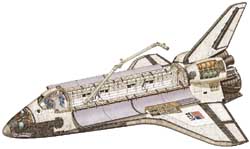DK Space: Space Shuttle
The United States created the Space Shuttle as a reusable launch vehicle to carry astronauts and cargo into space and back again. It is made from three parts—a winged ORBITER, an external fuel tank, and two solid rocket boosters (SRBs).
At liftoff, the orbiter’s main engines and the SRBs all fire together. Two minutes later, the SRBs separate and parachute back to Earth to be used again. About six minutes later, the external fuel tank separates and breaks up in Earth’s atmosphere. The winged orbiter uses its orbital maneuvering system (OMS) to reach the correct orbit.
The Shuttle is the main vehicle used to carry parts of the International Space Station (ISS) into orbit. It also carries new satellites into orbit and brings equipment to repair existing satellites. Other payloads (cargo) include space laboratories and telescopes, and smaller spacecraft that will go on to explore the Solar System.
This is the main part of the Space Shuttle that carries the crew and payload. It is thrust into space by rockets, operates as a spacecraft in space, reenters Earth’s atmosphere, and lands as a glider.
Table 15. LANDMARK ORBITER MISSIONS
| DATE | MISSION | ORBITER | EVENT |
|---|---|---|---|
| 1981 | STS-1 | Columbia | First Shuttle mission |
| 1995 | STS-71 | Atlantis | First linkup with Russia’s space station Mir |
| 1998 | STS-88 | Endeavour | First International Space Station mission |
The orbiter is designed to withstand the harsh conditions in space. The main structure is built from strong aluminum. For protection against heat, it is covered in insulating materials, such as thick ceramic tiles. Fuel cells mix hydrogen and oxygen to provide electrical power and water for drinking and bathing.

